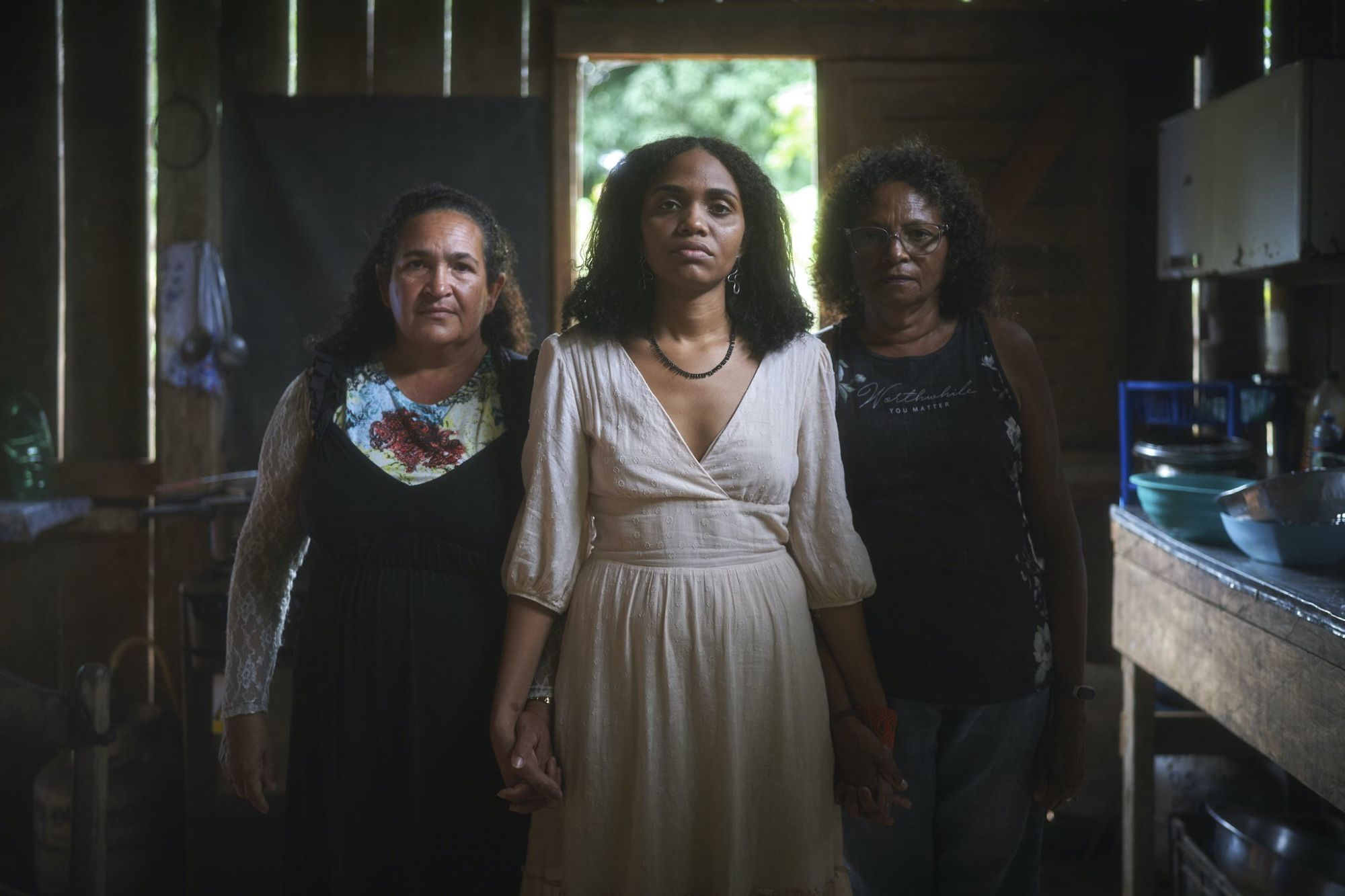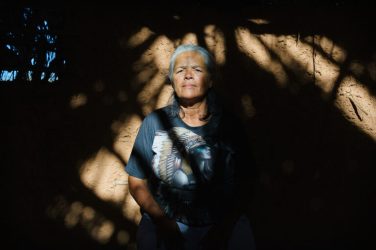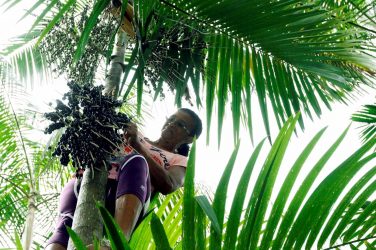Some 40 kilometers from the Brazilian city of Altamira, ‘Photograph Belo Monte’ is written in large, white letters next to the highway – inviting the public to stop and admire the monumental hydroelectric dam on the Xingu River.
It is here that Daniela Silva cries out, “Belo Monte is dead!”, as she lays down a poster handwritten with the same message.
Daniela’s family is among the more than 14,000 people displaced by the construction of the hydropower plant, which has violently disrupted the local ecosystem.
They were resettled in small, newly built houses known as ‘ruquis’ (a colloquial term for ‘collective urban resettlements’) far from the river they had lived alongside and no longer within walking distance of Altamira city center.
“Before, there was a really strong sense of community,” says Dani, as she is known locally. “When we were little girls, we played together in the streets, and the community took care of us while our parents went out to work or fish in the river.
“We belonged to the river, to the forest. We were happy. We were rich.”
The Belo Monte dam represents the extractivism that has dominated Brazilian politics, on the Left and the Right, for decades. Altamira and its community were forever changed between 2011 and 2013, when 45,000 workers came to construct it.
The families lost their jobs. The canoes were left without water. The communities could no longer fish. The islands flooded, and trees drowned and died, leaving a desolate landscape.
“Before I had a live river. Now I have a dead lake,” said Raimundo Berro Grosso, another member of the community, in a quote included in journalist Eliane Brum’s recent book about the Amazon, ’Banzeiro òkòtó’.
‘Pushed into misery’
We contacted Norte Energia, the company that operates the Belo Monte dam, to ask it to comment on an earlier version of this article, but it did not respond.
The construction of the ‘Belo Monster’, as it is known locally, unleashed a socio-environmental catastrophe whose consequences are still difficult to comprehend. It destroyed the habitat of a vast area known as Volta Grande do Xingu, and the lives and futures of the communities on its banks.
Dani’s father lost his job as a brickmaker. One of her brothers was shot in the back and killed when the police stormed the house of his friend, who was accused of dealing drugs, and another brother became depressed and died by suicide.
“Now we are poor. To be poor is to not be able to choose. To be poor is to beg for gasoline to go to the city center. It is to need money to buy a mango in the supermarket,” she continues.
Standing in front of the abandoned lot where her home once stood, Dani is overcome by tears.
“Belo Monte pushed the people into misery. It ripped us out of our homes, and it didn’t give us any tools to rebuild our lives,” she says. “That can never be replaced. Being poor, being miserable, is to not remember where we came from.”
Hundreds of families like Dani’s were torn apart by Belo Monte, which was conceived during the country’s military dictatorship from 1965 to 1985. It was designed as part of a project that initially involved a system of up to eight dams throughout the rivers of the lower Brazilian Amazon.
The same period also led to the overexploitation of the jungle and the construction of the Trans-Amazonian highway, which became the needle in an enormous syringe used for massive, systemic extraction of the resources of the tropical forest, which today is in ruins.
But in the 1980s, Belo Monte generated great opposition among Indigenous and riverside communities, and its funding was withdrawn by the World Bank as a result. The project was revived 20 years later with funding from Brazil’s public national development bank, and although it was still opposed by many, this time construction progressed, promoted by successive governments of the then-ruling Brazilian Workers’ Party.
The hydroelectric power plant was inaugurated twice: once by President Dilma Rousseff in May 2016, when the first turbine began operating, and again by President Jair Bolsonaro in November 2019, when the last turbine began and the plant became fully operational.
During the low rainfall season, only one of the 18 turbines is functioning – due to changes in the design of the dam which now operates following the seasonal variation of river flow – demonstrating the hubris of a project that is failing to produce the 11,000 megawatts of “clean sustainable energy” still advertised on signs around Altamira.
A feminist fight
Since the project was first announced in the 1980s, a series of female activists in Altamira – including Mónica Brito, Antonia Melo, Francineide Ferreira and Raimunda Gomes – have led the charge against it. These women inspired Dani, who, in the words of Eliane Brum, “invents herself as a warrior”.
The jungle is often compared to a violated woman’s body. It corresponds to the predatory conceptions of the Amazon shared by many Brazilians, particularly Bolsonaro and his followers.
Brum affirms this idea: “Being a woman is being a Xingu violated by Belo Monte. It is being a burned tree when the smoke covers the Amazonian sun to hide the horror of the crime.”
Dani’s fight fits squarely into this powerful image of the disaster in the Amazon basin. We are rapidly approaching a point of no return: some scientists predict that when the Amazon’s deforestation reaches 20-25%, much of the tropical forest will be turned into an immense savannah.
Against this dire threat, Dani is putting her body on the line. She participates in several anti-deforestation initiatives and works to strengthen civil society to confront the landowners who drive their trucks through Altamira, which the Belo Monte devastated and turned into the most violent city in all of Brazil.
Dani is aware that her fight for Altamira is also a fight for the Amazon, and for the entire planet, whose future is being destroyed on a daily basis.
“Fighting for the Amazon today is not an isolated fight. Defending the Amazon, the jungle, is defending life,” she says. “We are not here preventing the development that they talk about.
“When they build a hydropower plant in a sacred river like the Xingu, it is not only the Xingu that dies, along with the people, but it has a domino effect. It falls, it falls, it falls […] and poof.”
Pablo Albarenga is an Uruguayan journalist who works with indigenous peoples of the Amazon.
Francesc Badia i Dalmases is a Mexican journalist, a film producer, and the founder and director of democraciaAbierta, the Latin American associate section of openDemocracy.net, London. A political analyst, an author, and a publisher, Francesc specializes in geopolitics and international affairs. Francesc is a regular contributor to international newspapers like El País or The Guardian, a Pulitzer Center grantee, and was awarded the Gabo Prize in 2021 for his work in the Amazon. Follow him on Twitter: @fbadiad Instagram: francescbadiaidalmases3
This article appeared originally in Open Democracy – https://www.opendemocracy.net/













